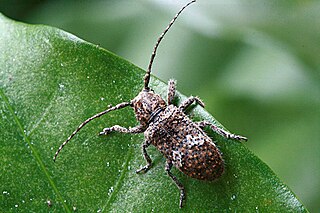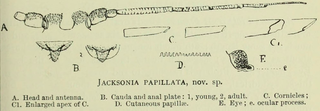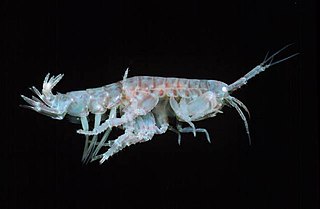
The family Archeocrypticidae is a small group of beetles with no vernacular common name, though recent authors have coined the name cryptic fungus beetles. Adults and larvae seems to be saprophagous and are often found in plant litter. Worldwide, about 10 genera and 50 species are found, most species are pantropical. Enneboeus caseyi has been recorded from the American South, Central America, and Mexico. About 20 species are found in Australia, in the genera Enneboeus,Australenneboeus and Gondwanenneboeus,Archeocrypticus,Falsoplatydema, Nothenneboeus, Sivacrypticus and Wattianus. They are largely absent from the Palearctic and Nearctic regions.
Eutrombicula is a genus of mites in the family Trombiculidae. The species of this genus are found throughout North America, and Australia.

Aaaaba is a genus of beetles from the Buprestidae family. It inhabits locations along the east coast of Australia. It was described in 1864 by Achille Deyrolle as "Alcinous", a junior homonym of a genus of pycnogonids. In 2002, Charles Bellamy gave it the replacement name "Aaaba", but this proved to be another junior homonym, of a genus of sponges. In 2013, it was given a further replacement name, becoming Aaaaba.
Aacanthocnema is a genus of bugs from the jumping plant lice family (Triozidae). The genus is endemic to Australia, and currently contains six species, found in all states and territories with the exception of the Northern Territory.

Polyzosteria is a genus of around sixteen species of cockroaches in the Blattidae family native to Australia. Some of these insects are attractively marked, such as Polyzosteria mitchelli. The type species of the genus is the Botany Bay cockroach, Polyzosteria limbata.
Copelatus divisus is a species of diving beetle. It is part of the genus Copelatus in the subfamily Copelatinae of the family Dytiscidae. It was described by Chris Watts in 1978.

Leptomyrmex tibialis is a species of ant in the genus Leptomyrmex. First described by Carlo Emery in 1895 as Leptomyrmex nigriventris tibialis, the species is endemic to Australia, and found in both New South Wales and Queensland. The arguments for synonymy were made by Lucky and Ward, and the decision was accepted by the Australian Faunal Directory.

Rhytiphora bankii is a species of beetle in the family Cerambycidae. It was first described by Johan Christian Fabricius in 1775, under the genus Lamia. It is known from Australia, the Philippines, Borneo, Java, Micronesia, New Guinea, Hawaii, Moluccas, Sumatra, Vietnam, and has been introduced into Japan. The Australian species of Prosoplus were synonymised with Rhytiphora in 2013.

Jacksonia is a genus of true bugs belonging to the family Aphididae.

Naineris is a genus of annelids belonging to the family Orbiniidae.
Mallada is a genus of lacewings belonging to the family Chrysopidae. The species of this genus are found in Africa, Southeastern Asia and Australia. The genus was first described by Longinos Navas in 1925, and by monotypy the type species is Mallada stigmatus.

Theonellidae is a family of sponges belonging to the order Tetractinellida, which was first described by Robert von Lendenfeld in 1903.

Epigonichthys is a genus of lancelets belonging to the family Branchiostomatidae. The genus was first described in 1876 by Wilhelm Peters. The type species is Epigonichthys cultellus.

Enteles is a genus of weevil in the family Curculionidae.
Guntheria is a genus of mites in the family Trombiculidae. The species of this genus are found in Australia and the islands to its north.
Austrochernes is a genus of pseudoscorpions in the subfamily Chernetinae, first described by Max Beier in 1932. The Australian Faunal Directory decisions for synonymy are based on a 2018 paper by Mark Harvey.

Paraproto is a genus of marine amphipods in the family, Caprellidae, and was first described in 1903 by Paul Mayer. The type species is Paraproto condylata.

Paraproto spinosa is a species of marine amphipod in the family, Caprellidae, and was first described in 1885 by William Aitcheson Haswell as Proto spinosa. In 1903 Paul Mayer transferred the species to the newly erected genus, Paraproto, and the species became Paraproto spinosa.

Ceradocus sellickensis is a species of amphipod in the subgenus, Denticeradocus, and the family, Maeridae, and was first described in 1939 by Keith Sheard. The holotype was collected at Sellicks Beach, in Gulf St Vincent. The species is endemic to Australia, and found only in South Australia.
Elasmopus arafura is a marine species of amphipod in the family, Maeridae, and was first described in 2011 by Lauren E. Hughes and James K. Lowry, from a specimen collected at "The Blow-holes", Point Quobba on an exposed intertidal rock shelf.












